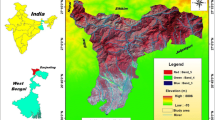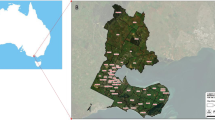Abstract
Planning for new urban–industrial communities in deserts is a main objective of the Egyptian government. Allocation of such communities should comply with both environmental protection and sustainable consumption of resources. The current study explores such approach, through mapping potential zones for new urban–industrial communities in Matrouh Governorate, Western Desert, Egypt. A spatial multidisciplinary approach has been adopted to facilitate zoning based on satellite data, spatial decision support systems and a geospatial model. Landsat 8, Shuttle Radar Topography Mission in addition to several thematic maps were input for the geospatial model. Three sub-models were created for three themes (visions), two of which were created using spatial multicriteria analysis (land resources and infrastructures), and the third sub-model, namely environmental protection, was created using a binary model. The analytical hierarchy process method was applied to assign relative weights for the resources theme, while the rank-sum method was used for the infrastructure theme. The three sub-models were aggregated to produce the suitability index for three zoning visions. Such index was classified and the highest three suitability values in each suitability index were extracted being the most optimum zones. Such zones are found in the northeastern part of the study area. The most optimum zones amounted to 23,863 km2, 47,707 km2 and 25,474 km2; equivalent to 14.8%, 29.7% and 15.9% for the first, second and third visions, respectively. The resultant maps can be used in site selection, allocation, decisions and for planning new urban communities.






Similar content being viewed by others
References
Abdel-Kader F (2015) Land resource assessment of landmine-affected areas, Northwest of Egypt. Research Gate, cited in 18-5-2018 at https://www.researchgate.net/publication/268302711
Aggour TA, Faid AM (2007) Hydrogeology of Siwa Oasis and landuse map, Egypt. J Remote Sens Space Sci 9:135–156
Alghais N, Pullar D (2018) Projection for new city future scenarios—a case study for Kuwait. Heliyon 4(3):e00590
Amer E, Almumen A (2002) Planning and design of environmental settlements: a case study of Kuwait. Postgrad J Archit Plan Landsc 5(1). University of Newcastle upon Tyne. Accessed from https://lucris.lub.lu.se/ws/files/5906883/2224661.pdf
Bailey DT (2005) Development of an optimal spatial decision-making system using approximate reasoning. Unpublished Ph.D. thesis submitted to Faculty of Built Environment and Engineering, Queensland University of Technology
Bunruamkaew K (2012) Site suitability evaluation for ecotourism using GIS & AHP: a case study of Surat Thani Province, Thailand. Ph.D. Dissertation submitted to the Graduate School of Life and Environmental Sciences, The University of Tsukuba
Center of Housing and Building Researches, Ministry of Housing, Utilities and Urban Development, Egypt (2007) Mines and quarry map of Egypt
Chakrabortty R, Pal SC, Malik S, Biswajit D (2018) Modeling and mapping of groundwater potentiality zones using AHP and GIS technique: a case study of Raniganj Block, Paschim Bardhaman, West Bengal. Model Earth Syst Environ 4:1085–1110
Climate-Data.org (2013). https://en.climate-data.org/location/3680/. Retrieved 21 Sept 2018
Collins MG, Steiner FR, Rushman MJ (2001) Land-use suitability analysis in the United States: historical development and promising technological achievements. Environ Manag 28(5):611–621
Eastman JR, Jin W, Kyem P, Toledano J (1995) Raster procedures for multicriteria multiobjective decisions. Photogramm Eng Remote Sens 61(5):539–547
Effat HA (2014) Resource-based Zoning/map for sustainable industrial development in North Sinai using remote sensing and multicriteria evaluation. Int J Sustain Dev Plan 9(1):119–134
Effat HA, Hegazy MN (2013) A multidisciplinary approach to mapping potential development zones in Sinai Peninsula, Egypt using remote sensing and GIS. J Geogr Inf Syst 5:567–583
EGPC, CONOCO-Coral (1987) Geological map of Egypt, Scale 1:500,000. EGPC, Cairo
Egyptian Environmental Affairs Agency (EEAA) (2007) Natural protectorates map. Ministry of Environment
Elbeih SF, Elkafrawy SB, Attia W (2019) Multi-criteria site selection and assessment of ports in the Northwestern Coast of Egypt: a remote sensing and GIS approach. Int J Environ Sci Dev 10(10):310–320
Food and Agriculture Organization of the United Nations (FAO) (2019) Africover landcover Web maps. Accessed 2019
General Organization for Physical Planning (GOPP) (2007) The environmental vision of the strategy of urban development in Egypt. Online Published Report. GOPP, Cairo, Egypt
Golany GS (1983) Design for arid regions. Van Nostrand Reinhold, New York, pp 1–334
GOPP (2010). Environmental vision for urban development strategy on the National Level for Alexandria Region (Alexandria, Matrouh and El-Buheira Governorate). General Organization for Physical Planning, GOPP report 2010. Accessed from: http://gopp.gov.eg/wp-content/uploads/2010/11/%D8%A7%D9%84%D9%85%D9%86%D8%B8%D9%88%D8%B1-%D8%A7%D9%84%D8%A8%D9%8A%D8%A6%D9%89-%D9%84%D8%A5%D9%82%D9%84%D9%8A%D9%85-%D8%A7%D9%84%D8%A5%D8%B3%D9%83%D9%86%D8%AF%D8%B1%D9%8A%D8%A9.pdf
Gradus Y, Stern E (2007) Changing strategies of development: toward a Regiopolis in the Negev Desert. J Am Plan Assoc 46(4):410–423
Hopkins L (1977) Methods for generating land suitability maps: a comparative evaluation. J Am Inst 34(1977):19–29
Ibrahim HG, Ahmed S (2003) Environmental assessment of the urban regions at industrial desert societies a case study: Abu Tartur mining area Egypt. In: Fifth international architectural conference in Assiut (IACA-V) on urbanization and environment
Information & Decision Support Center (IDSC) (2007) Census survey for Matrouh Governorate. Marsa Matrouh, Egypt
Jankowski P (1995) Integrating geographical information systems and multiple criteria decision making methods. Int J Geogr Inf Syst 9:251–273
Jiang H, Eastman JR (2000) Application of fuzzy measures in multi-criteria evaluation in GIS. Int J Geogr Inf Sci 14(2):173–184
Malczewski J (1999) GIS and multi criteria decision analysis. Wiley, New York
Malik A, Abdalla R (2016) Geospatial modeling of the impact of sea level rise on coastal communities: application of Richmond, British Columbia, Canada. Model Earth Syst Environ 2:146
Marinoni O (2004) Implementation of the analytical hierarchy process with VBA in ArcGIS. Comput Geosci 30:637–646
MHUD (2010) Ministry of Housing and Urban Development published report
MHUD (2011) Ministry of Housing and Urban Development published report
NRC (1987) Encyclopedia of Western Desert. In: Shata AA (ed) Cairo: National Research Center—Ministry of Scientific Research
Portnov BA, Hare A (1999) Desert regions—population, migration and environment. Springer, Berlin
Portnov BA, Safriel U (2004) Combating desertification in the Negev: dryland agriculture vs. dryland urbanization. J Arid Environ 56(4):659–680
Pramanik MK (2016) Site suitability analysis for agricultural land use of Darjeeling district using AHP and GIS techniques. Model Earth Syst Environ 2:56
Research Institute for Groundwater (RIGW) (1999) National Water Research Center (NWRC). The hydrogeological map of Egypt, scale 1:2,000,000
Romano G, Dal Sasso P, Trisorio Liuzzi G, Gentile F (2015) Multi-criteria decision analysis for land suitability mapping in a rural area of Southern Italy. Land Use Policy 48:131–143
Saaty TL (1980) The analytic hierarchy process. McGraw-Hill, New York, pp 20–25
Saaty TA (1992) Decision-making for leaders, 2nd edn. RWS Publication, Pittsburgh
Saaty TL (1997) A scaling method for priorities in hierarchical structures. J Math Psychol 15:234–281
Saaty TL (2008) Decision making for leaders: the analytic hierarchy process for decisions in a complex world. RWS Publications, Pittsburgh. ISBN 0-9620317-8-X
Sharifi MA, Zucca A (2008) Integrated planning and decision support systems: concepts, and application. In: Geneletti D, Abdullah A (eds) Spatial decision support for urban and environmental planning. A collection of case studies. Scholar Press, Kuala Lumpur, pp 5–31
Sharma RA (1983) A textbook of hydrology and water resources. Dhanpat Rai and Sons, Delhi, pp 738–739
Veron SR, Paruelo JM, Oesterheld M (2006) Assessing desertification. J Arid Environ 66:751–763
Voogd H (1983) Multi-criteria evaluation for urban and regional planning. Pion Limited, London
Author information
Authors and Affiliations
Corresponding author
Ethics declarations
Conflict of interest
The authors confirm that there is no conflict of interest.
Additional information
Publisher's Note
Springer Nature remains neutral with regard to jurisdictional claims in published maps and institutional affiliations.
Rights and permissions
About this article
Cite this article
Effat, H.A., Elbeih, S.F. A geospatial model for allocating potential urban–industrial zones in a desert: Case study Matrouh, Egypt. Model. Earth Syst. Environ. 6, 2033–2046 (2020). https://doi.org/10.1007/s40808-020-00806-w
Received:
Accepted:
Published:
Issue Date:
DOI: https://doi.org/10.1007/s40808-020-00806-w




